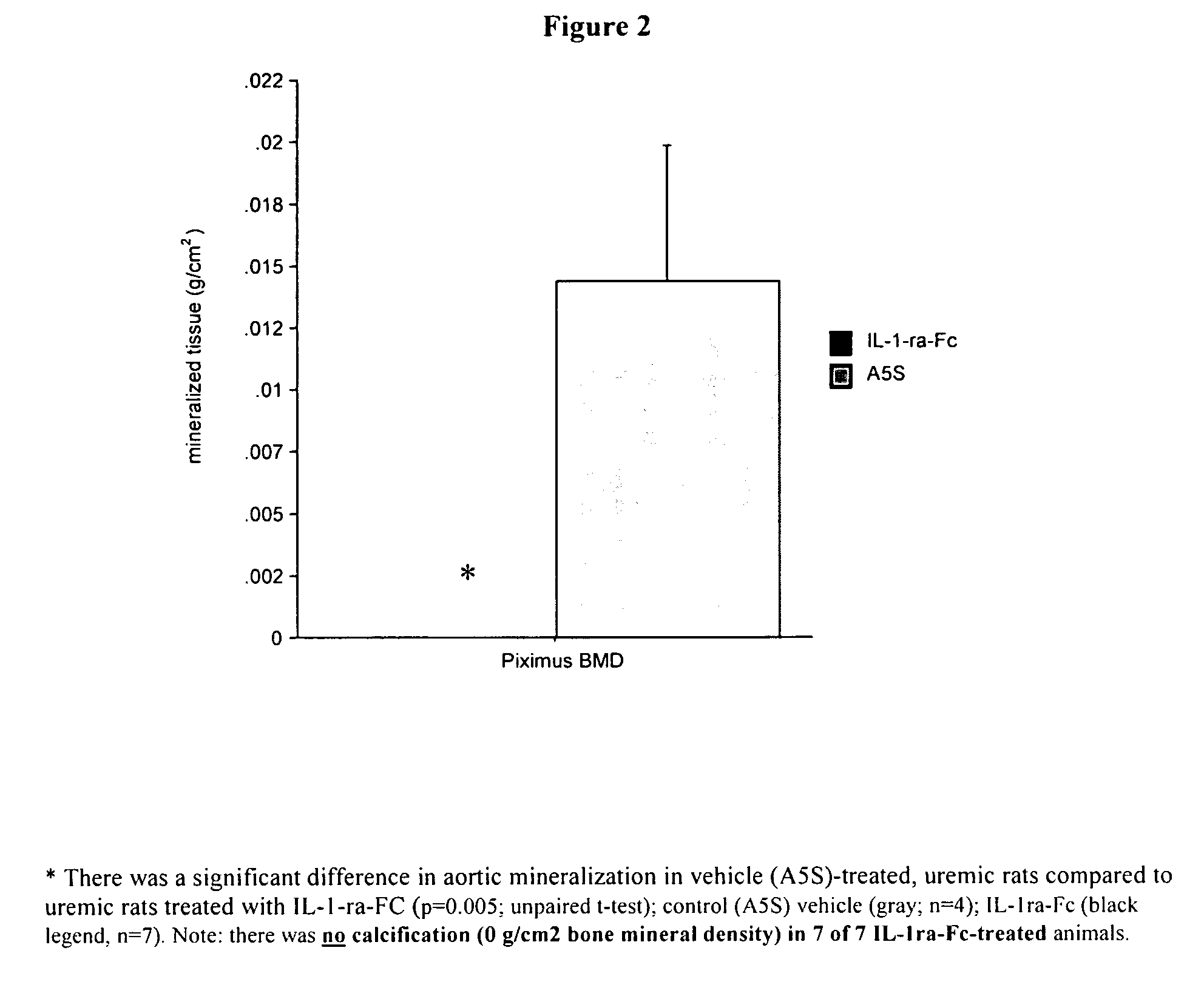Methods of decreasing vascular calcification using IL-1 inhibitors
a technology of il-1 inhibitors and calcification, which is applied in the field of medicine, can solve the problems of increasing the risk of cardiovascular morbidity and mortality, not adequately explaining the high mortality rate of cardiovascular causes in the patient population, and increasing the risk of vascular calcification, so as to achieve the effect of increasing serum creatinine and decreasing the level of serum creatinin
- Summary
- Abstract
- Description
- Claims
- Application Information
AI Technical Summary
Benefits of technology
Problems solved by technology
Method used
Image
Examples
example 1
Adenine-Induced Secondary Hyperparathyroidism (SHPT) and Calcification in Rats and Prevention of Aortic Vascular Calcification by Fc-IL-1ra
[0120] This experiment used the protocol shown in FIG. 1.
[0121] Adenine, included as a dietary supplement (0.75%), was fed to adult, male Sprague-Dawley rats. Blood for chemistry analyses (total serum calcium, phosphorous, blood urea nitrogen [BUN], creatinine, PTH) was collected before and again on drug treatment days 0 (pretreatment) and 21 from the retro-orbital sinus of anesthetized rats. Blood (0.5 ml) was collected for PTH levels into SST (clot activator) brand blood tubes and allowed to clot. Serum was removed and stored at −70° C. until assayed. PTH levels were quantified according to the vendor's instructions using rat PTH (1-34) immunoradiometric assay kit (Immutopics, San Clemente, Calif.). Calcium and phosphorous were measured using a blood chemistry analyzer (AU 400; Olympus, Melville, N.Y.).
[0122] Vascular calcification was asses...
example 2
Effect of IL-1ra on Vitamin D-Induced Vascular Calcification
[0124] The protocol used in this experiment may be summarized as follows.
[0125] PILOT: IL-1ra effects on vascular calcification.
[0126] Vitamin D 100 ng×3 weeks±IL-1 Ra (subcutaneous)→aortas for VC
[0127] Female, Lewis rats 250 g (pump implantation)
[0128] Vitamin D3, supplied as 1α, 25-dihydroxycholecalciferol from Sigma-Aldrich, Corp (St. Louis, Mo.), was dissolved in 90% ethanol to create a 1 mM stock solution that was stored at −20° C. until final dilution in phosphate buffered saline (PBS). Vitamin D3 (0.1 μg, in a dose volume of 0.2 ml PBS) was administered by subcutaneous (s.c.) injection.
[0129] IL-1ra
[0130] Dose 5 mg / kg / h SC infusion
[0131] Endpoint: Von Kossa
[0132] Groups (n=6 / group)
[0133] 1. Vitamin D 100 ng
[0134] 2. Vitamin D 100 ng+IL1-Ra (5 mg / kg / h SC)
[0135] 3. Vitamin D 100 ng+vehicle (pump)
[0136] 4. vehicle (n=2)
[0137] 21 days treatment
Sacrifice: remove aortas for von Kossa staining
example 3
Effect of Fc-IL-1ra on Vitamin D-Induced Vascular Calcification
[0138] The protocol used in this experiment may be summarized as follows.
[0139] PILOT: Fc IL-1ra effects on vascular calcification
[0140] Vitamin D 100 ng×3 weeks±Fc IL-1ra (subcutaneous)→aortas for VC
[0141] Female, Lewis rats 250 g and / or male, SD rats (250 g)
[0142] Vitamin D3, supplied as 1α, 25-dihydroxycholecalciferol from Sigma-Aldrich, Corp (D-1530-0.1 mg, St. Louis, Mo.), was dissolved in 90% ethanol to create a 1 mM stock solution that was stored at −20° C. until final dilution in phosphate buffered saline (PBS). Vitamin D3 (0.1 μg, in a dose volume of 0.2 ml PBS) was administered by subcutaneous (s.c.) injection.
[0143] Fc IL-1ra
[0144] Dose 100 mg / kg SC / day
[0145] Endpoint: Von Kossa
[0146] Groups (n=6 / group)
[0147] 1. Vitamin D 100 ng
[0148] 2. Vitamin D 100 ng+Fc IL1-Ra (100 mg / kg / d SC)
[0149] 3. Vitamin D 100 ng+vehicle (pump)
[0150] 4. vehicle (n=2)
[0151] 21 days treatment
[0152] Sacrifice: remove aort...
PUM
| Property | Measurement | Unit |
|---|---|---|
| thickness | aaaaa | aaaaa |
| disorder | aaaaa | aaaaa |
| bone mineral density | aaaaa | aaaaa |
Abstract
Description
Claims
Application Information
 Login to View More
Login to View More - R&D
- Intellectual Property
- Life Sciences
- Materials
- Tech Scout
- Unparalleled Data Quality
- Higher Quality Content
- 60% Fewer Hallucinations
Browse by: Latest US Patents, China's latest patents, Technical Efficacy Thesaurus, Application Domain, Technology Topic, Popular Technical Reports.
© 2025 PatSnap. All rights reserved.Legal|Privacy policy|Modern Slavery Act Transparency Statement|Sitemap|About US| Contact US: help@patsnap.com



